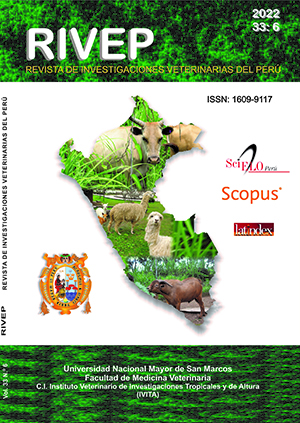Development of a stochastic simulation model to evaluate costs of porcine cysticercosis control programmes
DOI:
https://doi.org/10.15381/rivep.v33i6.24101Keywords:
Taenia solium, porcine cysticercosis, cost, stochastic simulation, vaccine, oxfendazoleAbstract
The aim of this study was to develop a stochastic simulation model to estimate implementation costs of porcine cysticercosis (CP) control programmes. Three scenarios were proposed: (1) use of a commercial recombinant vaccine (RV), (2) mixed use of RV plus oxfendazole (OFZ), and (3) dosing with OFZ. To establish the efficacy of the interventions, the probabilities of elimination of cysticercosis were obtained through the “cystiSim” agent-based model. The cost model was developed in R with 10 000 iterations. It was found that the mixed scenario offered a probability of 0.987 eliminating cysticercosis in 6.5 years and with an annual cost of S/. 335,208 (95% CI: S/ 309,922 – 368,698) (1 US$ = S/. 3.75). In contrast, the dosing strategy with OFZ proved to be less expensive with S/. 260,518 (95% CI: S/ 237,559 – 293,704) per year and a probability of elimination of 0.951 in the same evaluation period. In scenarios 1 and 2, the drug cost category is the highest, representing about 50% of the final cost, while in scenario 3, the highest cost is personnel, followed by drugs. The work concludes that the dosing strategy with OFZ is the least expensive alternative of the proposed scenarios.
Downloads
Downloads
Published
Issue
Section
License
Copyright (c) 2022 Linda Gallegos, Juan Calcina, Eliana Icochea, Eloy Gonzales, Luis A. Gomez-Puerta, Armando E. González

This work is licensed under a Creative Commons Attribution 4.0 International License.
AUTHORS RETAIN THEIR RIGHTS:
a. Authors retain their trade mark rights and patent, and also on any process or procedure described in the article.
b. Authors retain their right to share, copy, distribute, perform and publicly communicate their article (eg, to place their article in an institutional repository or publish it in a book), with an acknowledgment of its initial publication in the Revista de Investigaciones Veterinarias del Perú (RIVEP).
c. Authors retain theirs right to make a subsequent publication of their work, to use the article or any part thereof (eg a compilation of his papers, lecture notes, thesis, or a book), always indicating the source of publication (the originator of the work, journal, volume, number and date).










